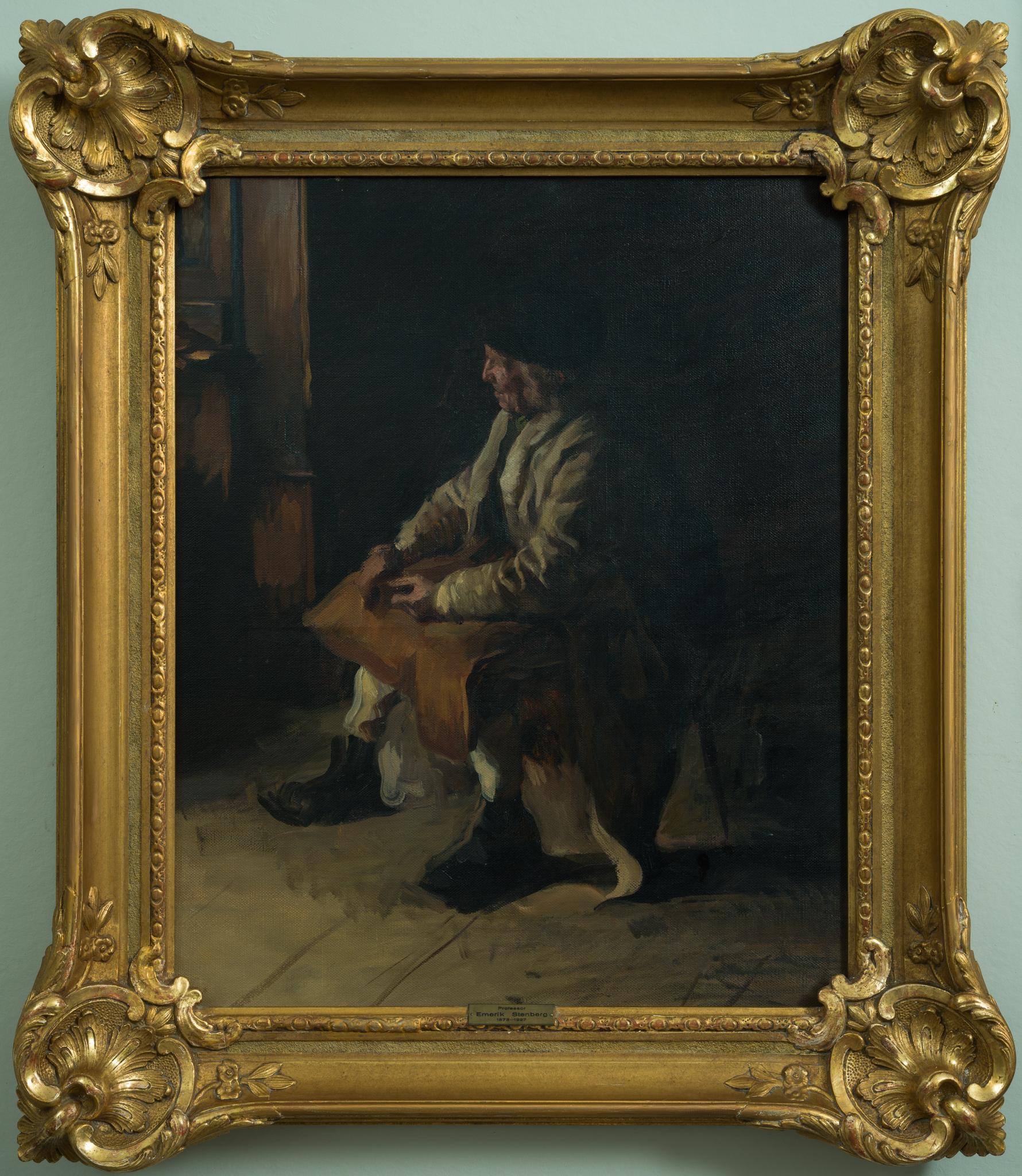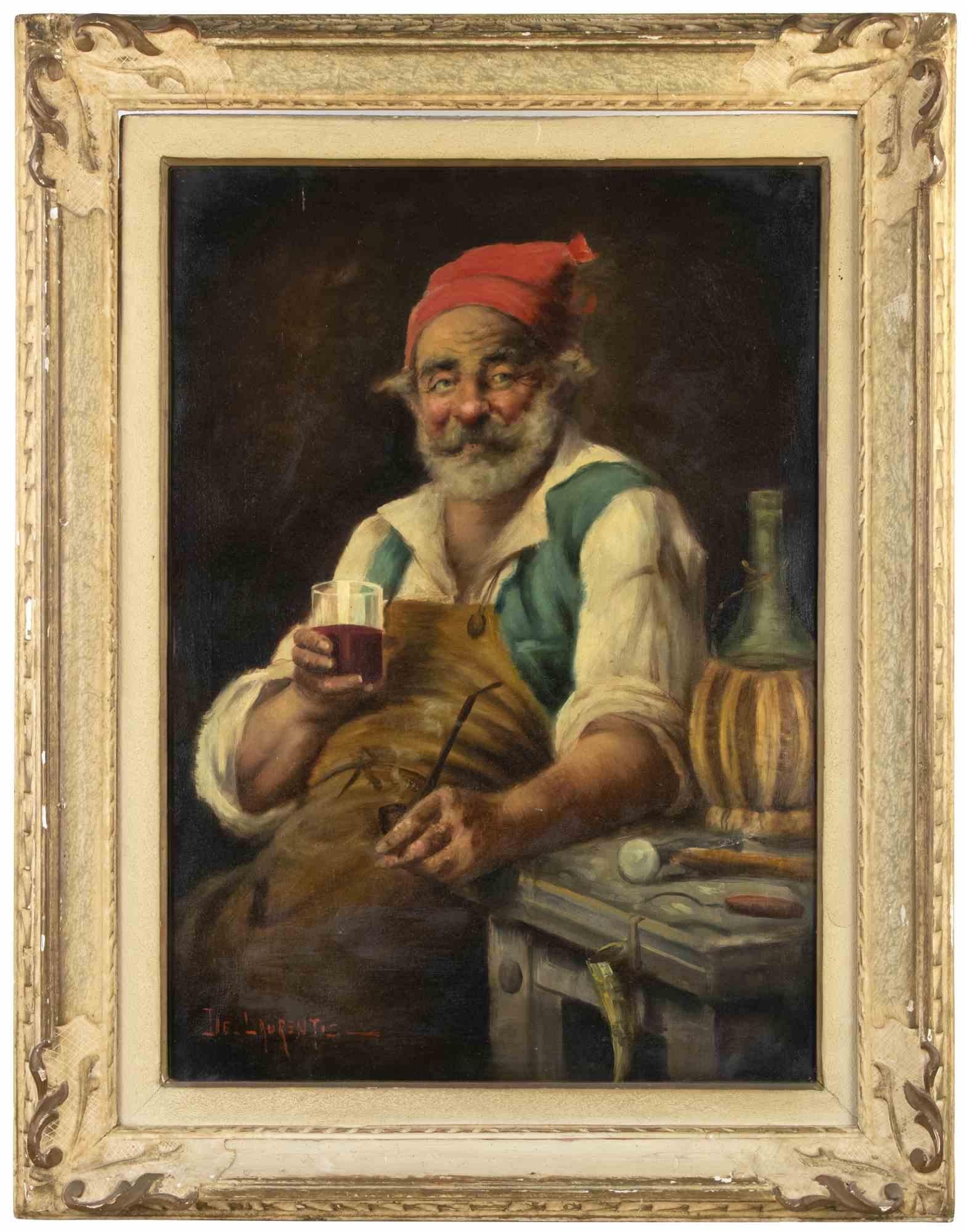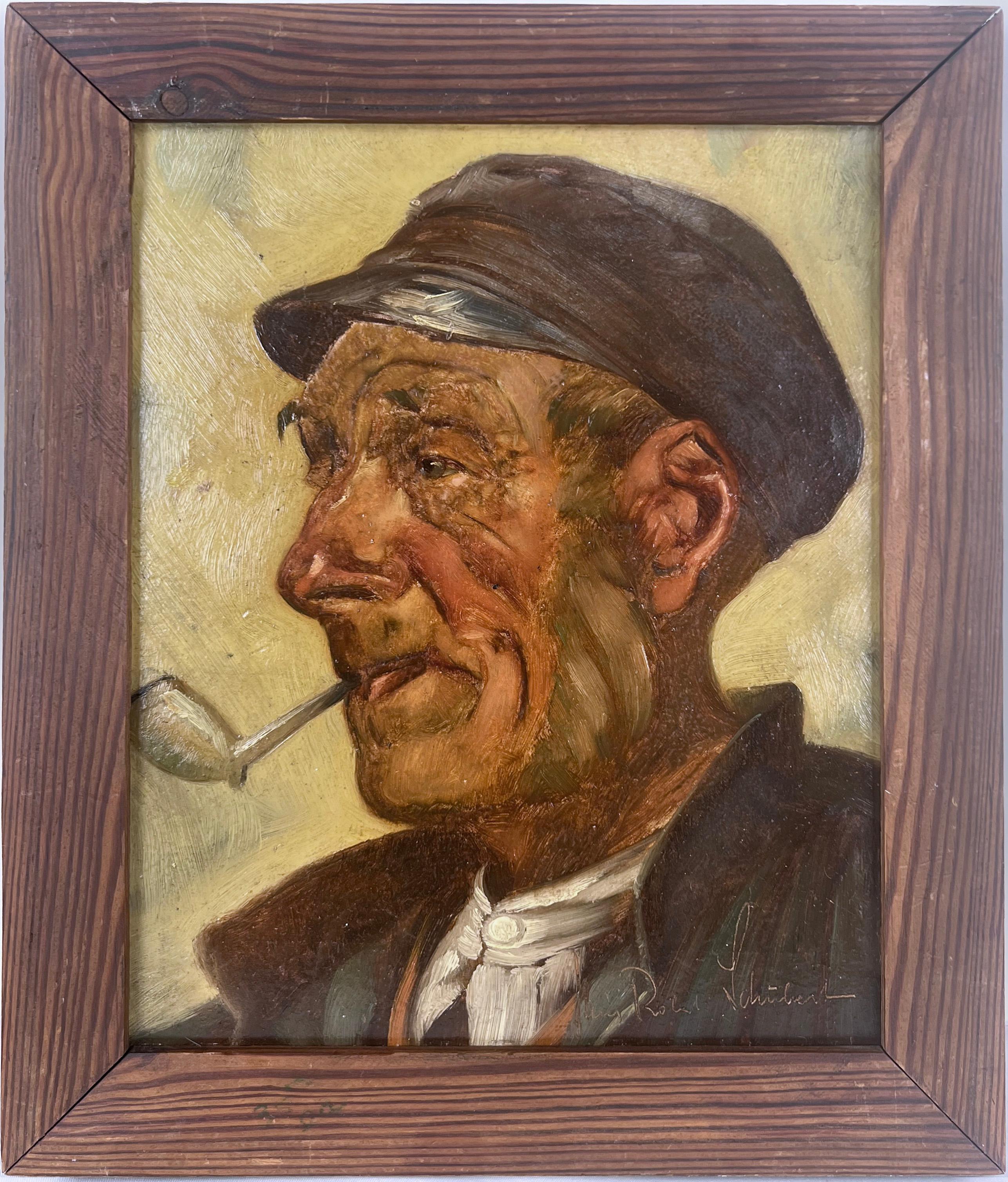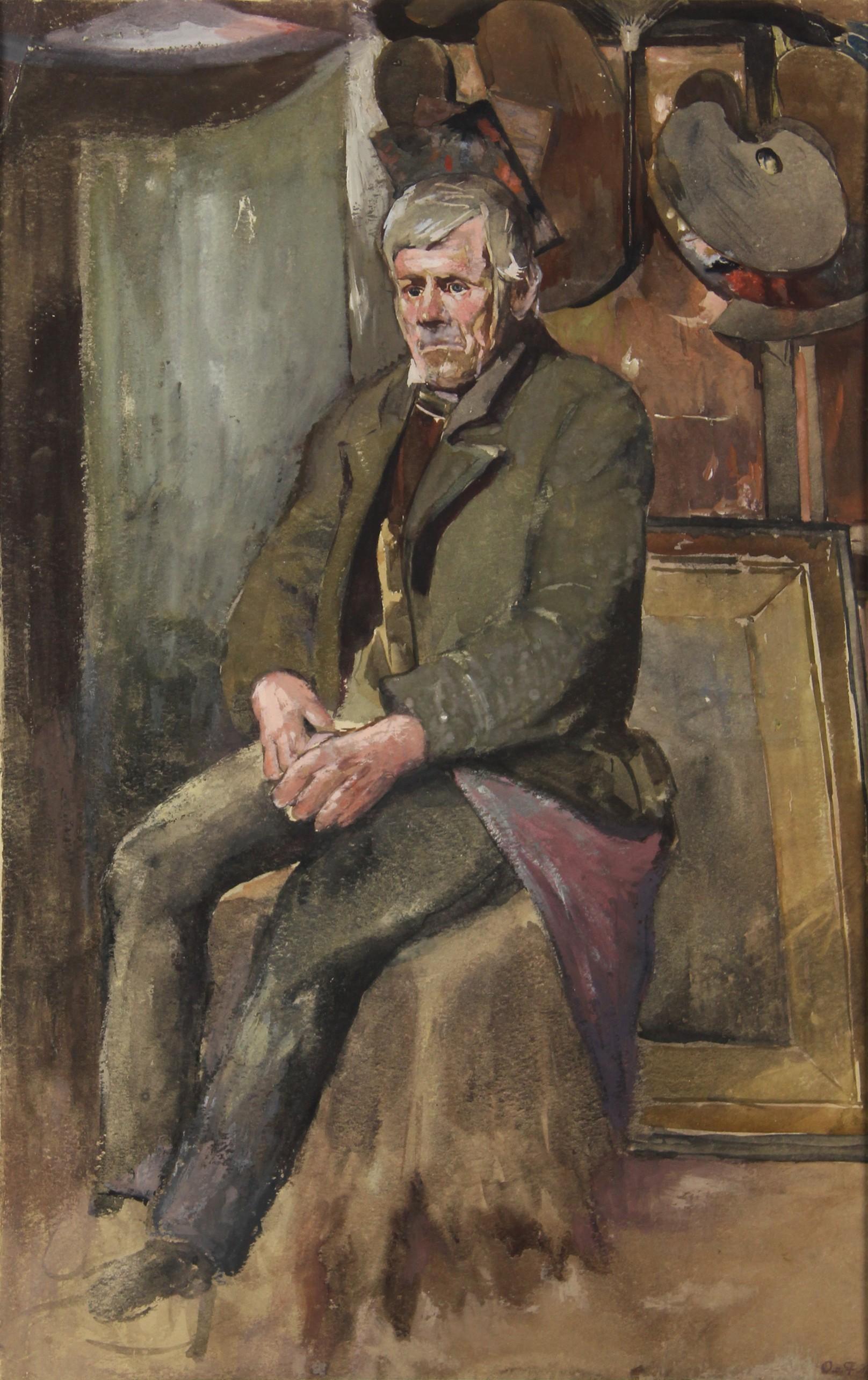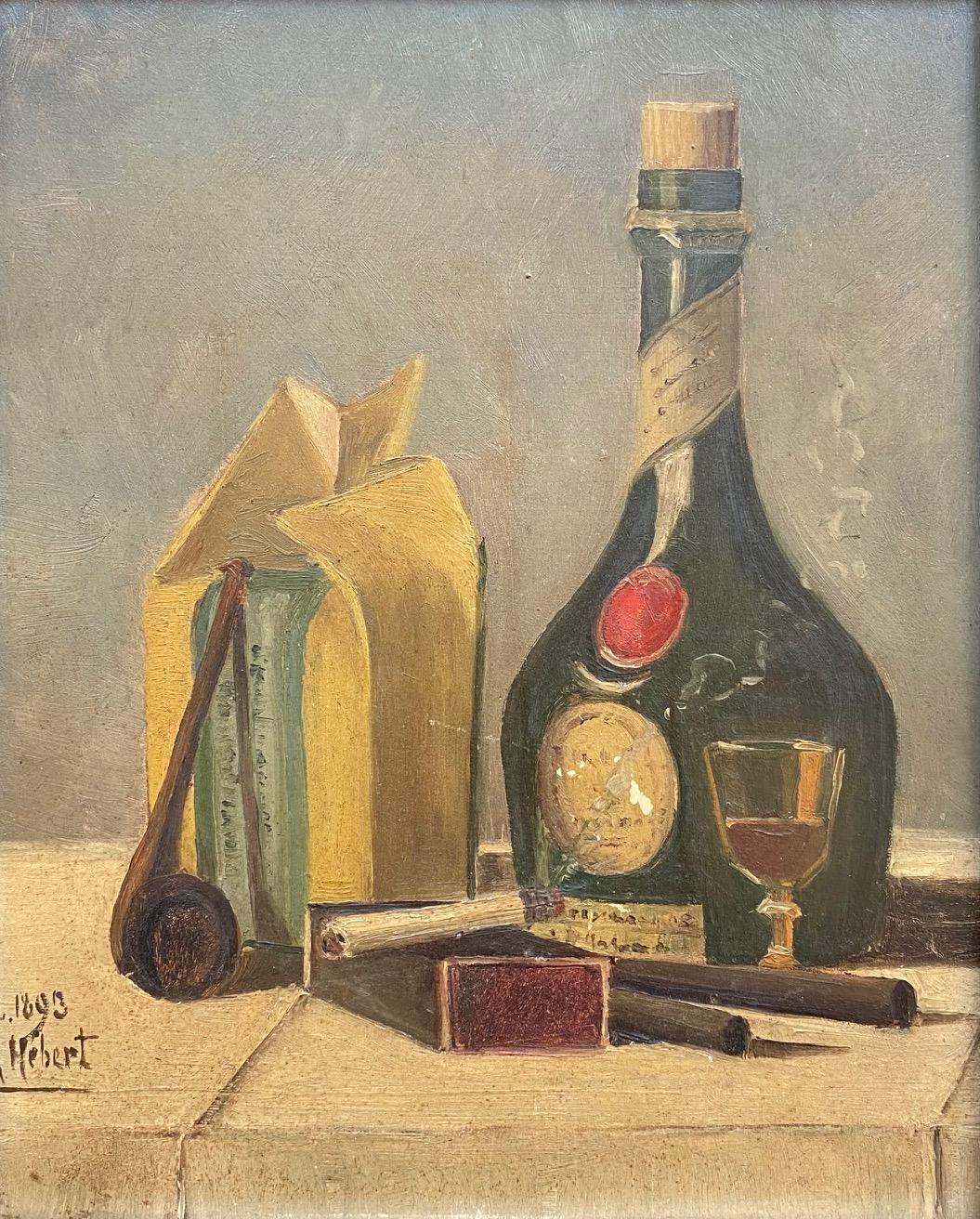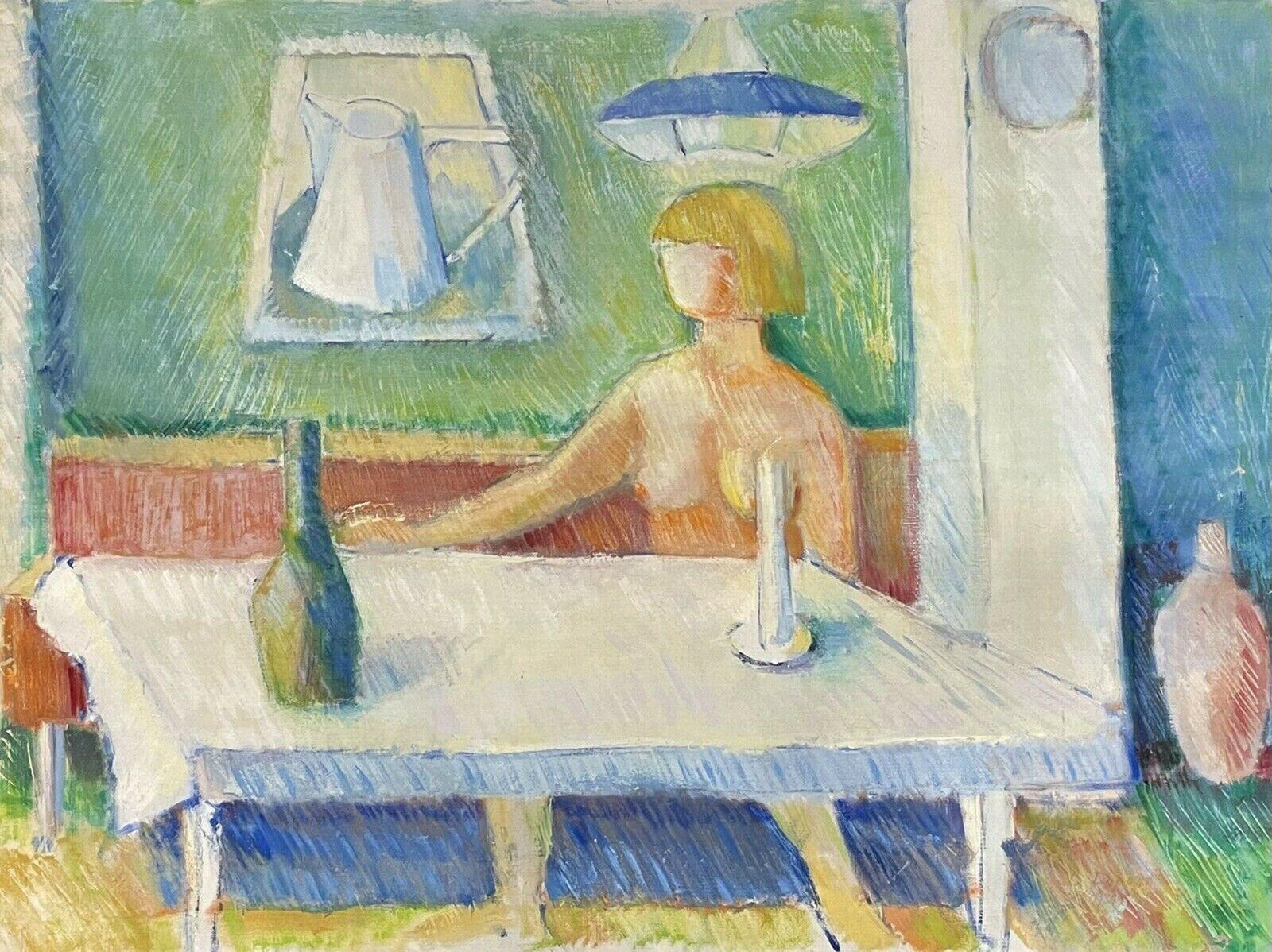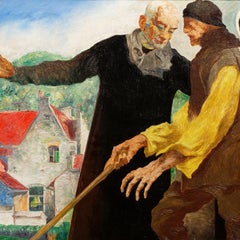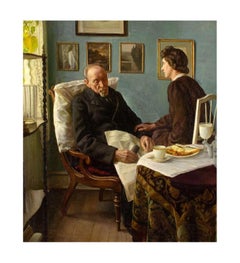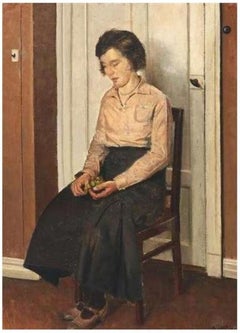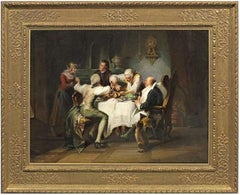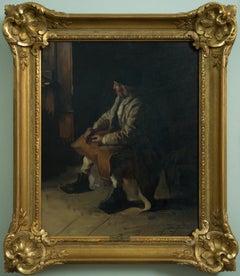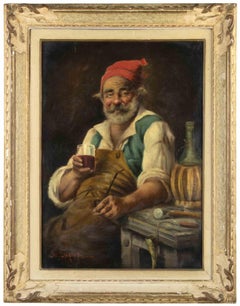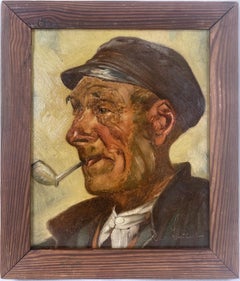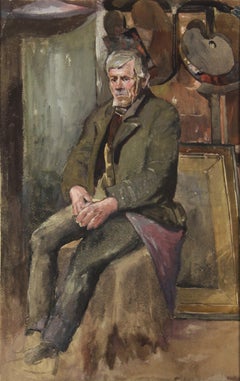Items Similar to Farmer busy eating his lunch, (I think he's just boozing) by Axel Soeborg
Want more images or videos?
Request additional images or videos from the seller
1 of 14
Axel SoeborgFarmer busy eating his lunch, (I think he's just boozing) by Axel Soeborg
$6,881.04
£5,111.46
€5,750
CA$9,492.88
A$10,435.28
CHF 5,484.31
MX$126,722.35
NOK 68,415.35
SEK 64,818.73
DKK 43,771.98
About the Item
Søeborg, Axel (1872-1939)
The ochre yawn of autumn and the bitter sleep of winter are the preoccupations of Danish artist Axel Søeborg's landscapes. With his singular hand, Søeborg spent twenty years capturing the rich palette of the Nordic countryside. He also had a penchant for dark interiors and contemplative, psychological self-portraits.
Søeborg's artistic career began as a house painter, but he soon changed his mind and turned to a more refined style of art. He began his studies at the drawing school of the Vermehren brothers, Gustav and Sophus, sons of the eminent Frederik Vermehren (1823-1910). His training continued at the Royal Danish Academy of Fine Arts, and with the figure painters Laurits Tuxen (1853-1927) and Peter Alfred Schou (1844-1914). Schou's dark interiors and moody scenes were Søeborg's greatest source of inspiration.
Søeborg lends a contemplative, insightful atmosphere to close-up, curious depictions of simply furnished interiors. The gaze of his subjects, usually himself and an unknown woman, is imbued with psychological intensity. They fix the viewer with a piercing gaze. Combined with a strong use of shadow to envelop the rooms in intimacy, and a radiant use of light to make his subjects the focus of the scenes, the viewer is drawn into a scene filled with emotion.
Indeed, his self-portraits in particular have this intense quality. A striking Søeborg is depicted in strong, almost cubist lines, in profile but with his eyes fixed on the viewer. His gaze is heavy, his eyebrows very pronounced. Søeborg's strong use of light and shadow adds to the gravity, giving the scene a curious, otherworldly effect. One gets the impression that melancholy thoughts lurk behind those eyes. Combined with the darkness of the room, the tone is pensive and somber.
It's interesting to wonder what the painting offered Søeborg. Perhaps it was a mirror in which he could reflect the way he saw himself and the world around him. The psychological aspect that seems to underlie these works could be the cause. Whatever the case, it seems clear that he felt the emotional intensity of painting and used it to experiment with the medium as well as to explore his own perception of himself.
Beyond the interior, Søeborg also found much inspiration in the natural world. During the twenty years he spent living and traveling in Sweden, he captured the changes and transformation of nature as the seasons passed.
From Jamtland to Dalarna, across Småland, Søeborg's psychological brush seems to capture the emotion as well as the physical changes of nature.
Through his judicious use of lighting, Søeborg seems to imbue his canvases with the mood of nature. An autumn fire sets her canvas ablaze with ochre and earthy umber, obscuring the sky. A silvery sheet of suffocating winter descends on a village, smothering it in snow and adding an oppressive coldness. Then spring arrives, piercing the veil of immobility. Water flows freely, reflecting the bare arc of a stretched branch. The sumptuous grass and brightening sky in the background promise new life.
These fascinating representations of nature and the self did not enjoy immediate success in the art world. However, thanks to numerous exhibitions throughout Europe, Søeborg eventually gained recognition. A solo exhibition in 1937, one of many, sealed the deal. Søeborg died unexpectedly two years later.
Today, many of his works are preserved in museums in Aalborg and Sønderborg, Denmark.
- Creator:Axel Soeborg
- Dimensions:Height: 26.38 in (67 cm)Width: 26.38 in (67 cm)Depth: 1.58 in (4 cm)
- Medium:
- Movement & Style:
- Period:
- Condition:
- Gallery Location:Gent, BE
- Reference Number:1stDibs: LU2140213775342
About the Seller
5.0
Vetted Professional Seller
Every seller passes strict standards for authenticity and reliability
Established in 2018
1stDibs seller since 2022
5 sales on 1stDibs
Typical response time: 2 hours
- ShippingRetrieving quote...Shipping from: Gent, Belgium
- Return Policy
Authenticity Guarantee
In the unlikely event there’s an issue with an item’s authenticity, contact us within 1 year for a full refund. DetailsMoney-Back Guarantee
If your item is not as described, is damaged in transit, or does not arrive, contact us within 7 days for a full refund. Details24-Hour Cancellation
You have a 24-hour grace period in which to reconsider your purchase, with no questions asked.Vetted Professional Sellers
Our world-class sellers must adhere to strict standards for service and quality, maintaining the integrity of our listings.Price-Match Guarantee
If you find that a seller listed the same item for a lower price elsewhere, we’ll match it.Trusted Global Delivery
Our best-in-class carrier network provides specialized shipping options worldwide, including custom delivery.More From This Seller
View AllThe blind man, oil on canvas by Maurice Langaskens
By Maurice Langaskens
Located in Gent, VOV
A masterfully painted scene originating from the artist's studio
In this painting, Langaskens brings together several motifs that were also the subject of his graphic work: the blind man, the priest, the nun and the farm that also appears in the famous etching "les toits rouges" (the red roofs). These elements are brought together in a dynamic and colourful composition, where the similarities to that other Belgian painter, Anto Carte, are striking.
Combining these elements in this way creates a certain tension. Is the work about mercy (helping a blind man), or are we spectators of a scene where a poor wretch's purse is stolen?
Striking is the use of impasto, in which the painter emphasises the texture of fabrics and skin via flowing lines.
Maurice Langaskens 1884 - 1946 Biography
A Belgian painter and printmaker, Maurice (Maurits) Langaskens enrolled in the Académie Royale des Beaux-Arts in Brussels in 1901, and was trained as a decorative painter by the leading Belgian muralist and sculptor Constant Montald. From early on, Langaskens was recognized as a fine draughtsman, and won several prizes at the Académie. After living and studying for a few months in France in 1906, mainly in Dijon, the young Langaskens settled in Schaerbeek, outside Brussels. He began his independent career in 1907, when he exhibited three decorative paintings at the Salon in Brussels for the first time and also had an exhibition of his work shown at the Salle Boute in the city. The following year he contributed six paintings to the 16th annual exhibition of the Belgian artist’s association ‘Pour l’Art’ in Brussels, where he was to exhibit frequently over the course of his later career, until 1941. (Langaskens also designed the poster for the 17th ‘Pour l’Art’ exhibition in 1909.) Also in 1908, one of his paintings was selected for an exhibition of modern Belgian art in Berlin. Much of Langaskens’s early work was in a vibrant and visually arresting Art Nouveau or Symbolist style. This bold and colourful manner also translated well into large-scale mural commissions, and he soon became one of the leading painter-decorators of the early 20th century in Belgium. His decoration of the town hall of the city of Zoutleeuw in 1912 earned the artist considerable fame and the praise of his teacher and mentor Montald: ‘He was one of the best students in the class; today he is the most outstanding artist among the decorators of our time.’ The same year the first of several exhibitions of Langasken’s work was mounted at the Cercle Artistique et Littéraire in Brussels. The outbreak of the First World War, however, brutally interrupted the rise of the artist’s successful career. Drafted into the Belgian army at the beginning of August 1914, Langaskens was captured by the Germans after less than a fortnight. He spent the next three and half years as a prisoner of war, at internment camps at Sennelager, Münsterlager and Göttingen. He produced numerous, mostly small-scale paintings and watercolours of portraits and depictions of many of his fellow prisoners, as well as scenes of daily camp life, that are today regarded as among his finest and most personal works. It was also during this period that he painted two of his best-known pictures, the large canvas In Memoriam, painted in 1916 and depicting the burial of a Belgian soldier by his comrades, and the monumental triptych Repose en Paix, painted between 1915 and 1918. After his liberation and return to Belgium, Langaskens exhibited over eighty of the paintings and drawings that he had produced as a prisoner of war at the Galerie Sneyers in Brussels in 1918. After the Armistice, Langaskens - suffering from aphasia and nervous disorders brought about by his long confinement - painted mainly easel pictures of winter landscapes, rustic genre scenes and floral subjects, and also produced a number of designs for tapestries, book illustrations and stained-glass windows. Within a few years, however, his health had recovered and he returned to undertaking large-scale decorative mural commissions. In 1920 Langaskens was one of the founders, alongside Montald, Jean Delville, Emile Fabry...
Category
20th Century Figurative Paintings
Materials
Canvas, Oil
Interior with Elderly Man Sleeping - Sophus Vermehren (1866-1950)
Located in Gent, VOV
Sophus Vermehren's "Interior with Elderly Man Sleeping" (1944) captures an intimate, tender moment within a domestic setting, exuding a deep sense of reflection and somberness. Paint...
Category
1940s Realist Interior Paintings
Materials
Oil
Oil on canvas "Woman with grapes", 1933+ by Søeborg Axel (1872-1939)
Located in Gent, VOV
This captivating oil on canvas by Axel Søeborg depicts a woman elegantly holding a bunch of grapes. Painted in 1933, this artwork showcases the artist's masterful use of color and li...
Category
1930s Modern Portrait Paintings
Materials
Oil
Gaisser Jakob Emanuel (1825 -1899)+ Rococo Society at a Gluttony
Located in Gent, VOV
Rococo Society at a Gluttony
A group of gentlemen sitting at a table in a salon, greedily eating a roast, on the left an elderly woman asking for a gift. An expressive narrative gen...
Category
Late 19th Century Rococo Figurative Paintings
Materials
Oil
Afternoon tea , 1912 Oil on canvas Auguste Moreau-Deschanvres (1838-1913)
Located in Gent, VOV
Auguste Moreau-Deschanvres (1838-1913)
A student of Julien Potier at the Valenciennes academic schools, the painter Auguste Moreau-Deschanvres (1838-1913) lived in the house-studio h...
Category
20th Century Figurative Paintings
Materials
Canvas, Oil
Oil on pannel "The old fisherman woman" By Boudry Aloïs (1851-1938)
Located in Gent, VOV
This captivating oil on panel painting by Belgian artist Aloïs Boudry (1851-1938) is a testament to his mastery of realism. Titled "The Old Fisherman Woman," the artwork depicts a we...
Category
Late 19th Century Realist Figurative Paintings
Materials
Oil
You May Also Like
The Seated Man – An Intimate Glimpse into Daily Life
Located in Stockholm, SE
This masterfully executed painting by Emerik Stenberg (1873–1927) captures an intimate and atmospheric moment. The composition features a seated man, engrossed in his daily chores, b...
Category
Early 20th Century Realist Figurative Paintings
Materials
Canvas, Oil
Man with a Glass of Wine - Painting by Adriano De Laurentis - mid-20th Century
Located in Roma, IT
Man with a Glass of Wine - is a modern artwork realized by the painter Adriano De Laurentis.
Mixed colored oil painting on canvas.
Includes frame.
Hand signed on the lower margin.
Category
Mid-20th Century Modern Abstract Paintings
Materials
Oil, Canvas
Portrait of a Man Smoking a Pipe in Oil on Masonite
Located in Soquel, CA
Portrait of a Man Smoking a Pipe in Oil on Masonite
Detailed portrait of a man with a pipe by Heinz Robert Schubert (German, 1912-2001 approx.). A man wearing a short-brimmed hat is...
Category
1940s Realist Portrait Paintings
Materials
Masonite, Oil
$680 Sale Price
20% Off
Man sitting in the studio - Thinking about art -
Located in Berlin, DE
Adolph Eduard Otto von Faber du Faur (1828 Ludwigsburg - 1901 Munich). Man sitting in the studio. Watercolour painting, 43 x 27 cm (visible size), 73 x 53 cm (frame), monogrammed at lower right, estate stamp.
Upper right corner neatly repaired, small tear in the wall to the left of the sitter.
- Thinking about art -
About the artwork
The sitter, an elderly man, is seated in a studio on a pedestal reminiscent of an academy hall. The earthy, dark tones give the scene a weighty quality. The lightest tones are found in the incarnate parts of the figure, which do not stand out from the other colours of the picture, but are linked to them. As a result, the sitter's face is both part of and the highlight of the colour references in the picture. The colour of the sitter's skin is reflected in his pink coat, while his white-grey hair matches the colour of the wall next to him. This almost monochrome wall surface, in turn, is connected across the portrait to the framed picture standing on the floor, which seems to have been erased by this correspondence with the empty wall surface. Through the palette, which is positioned directly behind the sitter's head, the reference to painting, which is already given by the studio space, is explicitly linked to the sitter, who thus seems to be contemplating the question of the meaning of art.
This raises the question of whether Faber Du Faur, who had become lonely in his old age, might have painted a self-portrait here in his later years. In addition to the studio setting, the sitter's explicit reference to the palette and the fact that the picture was part of his estate, the only summary elaboration of the body suggests a self-portrait, while the representation of the face is concretised with the wide-open eyes typical of a self-portrait. This concentration on the face gives the impression of the artist's melancholy introspection, captured by the palette and related to the meaning of painting, whose dark character is reinforced by the concealment of the palette hanging on the right of the picture in the light tones so characteristic of Faber Du Faur. In the course of this resignation, Faber du Faur advises his son Hans, who has also become a painter: "Promise me one thing: never move to Munich, they'll kill you here!"
Whoever the sitter may be, the references to painting make the portrait a resigned self-contemplation by Faber Du Faur, focused on art.
About the artist
After leaving school, Otto Faber du Faur entered the service of the Württemberg army, at the same time cultivating his artistic talent. In 1851, on the recommendation of his father Christian Wilhelm, who was himself a battle painter, he spent six months in Munich as an apprentice to Alexander von Kotzebue. In 1852 he was granted a year's leave of absence from military service to study battle painting in the studio of Adolphe Yvon...
Category
1890s Realist Portrait Drawings and Watercolors
Materials
Watercolor
$909 Sale Price
20% Off
Smoking a pipe and drinking wine (1893) - Henri Hebert Swiss school
Located in Geneva, CH
Henri A. Hebert was born in Geneva in the 19th century. Genre painter and son of Jules Hebert both belonging to the Swiss school. The Geneva museum prese...
Category
1890s Modern Still-life Paintings
Materials
Oil
$960 Sale Price
20% Off
SWEDISH MID 20TH CENTURY HUGE OIL PAINTING - FIGURE DRINKING AT BISTRO TABLE
Located in Cirencester, Gloucestershire
Artist/ School: Swedish School, 20th century, indistinctly signed.
Title: The cafe table.
Medium: oil painting on canvas, framed
Size: framed: 35...
Category
20th Century Interior Paintings
Materials
Canvas, Oil
More Ways To Browse
Dark Moody Oil Landscape Painting
Farmer Oil Paintings
Winter Village
Danish Artist Landscape
Laurits Tuxen
Circus Horse
Circus Horses
Francoise Jean
Isabel Rock
J C Leyendecker
Jean Lasnier
Martini Oil Painting
Master Copy Painting
Naked Girl
Oil Painting Sailor
Pre Raphaelite Oil Paintings
St Louis Painting
Swimming Underwater
